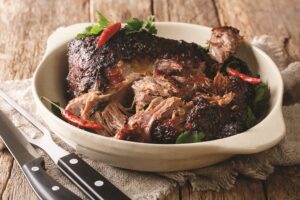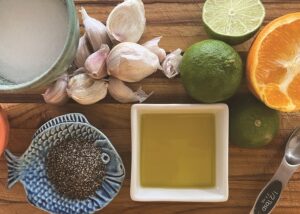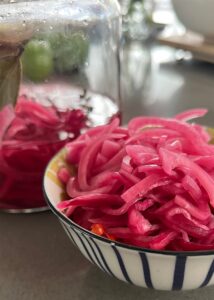One thing I’m realizing now that Truro is truly our home is that there are of lots of people we will only get to catch up with in the summer. And people gotta eat. Grilling is the obvious answer to the question of how to keep things cool and easy.
I was thinking along those lines as I made my way through the Stop & Shop this week when I saw pork shoulder on sale. Now I had a plan.

Besides that I’m a sucker for a good sale, pork shoulder puts me in mind of our first trip to Puerto Rico. It was a work trip for Christopher. But I fell in love with the mofongo, mashed plantains, which we ate at a café in Ponce; the grilled octopus at the market in Santurce, where a woman at the next table split open her fresh avocados to share with us; the sparkling seafood we splurged on at Pikayo at the Museo de Arte de Puerto Rico; and slow-roasted pernil.
We first tasted pernil at a roadside restaurant where metal drums, cut in half, were repurposed for an outdoor kitchen. The word comes from the Spanish word pierna, leg, and in Puerto Rico and many other places in Latin America it refers to a specific cut: pork shoulder, on the bone. It also refers to a cooking technique — slow roasting, preferably over an outdoor fire.
There are national, regional, and family versions of this dish, but all use the same basic ingredients — salt, pepper, herbs, and garlic. Pernil is one of those magically simple preparations that transforms a relatively inexpensive cut of meat into a sumptuous feast. The shoulder is roasted with the skin on and the layer of fat under it basting the meat and slowly browning to become a crispy chicharrón.

Before it goes on the grill, the skin is partially cut away from the meat and an adobo — a marinade — is rubbed on. In addition to the standard four adobo ingredients, many recipes include a touch of acidity to tenderize the meat. My research led me to sour oranges, but since those can’t be found on the Cape, I decided on a mixture of orange juice and lime juice, reinforced with a jolt of vinegar, which gave the adobo a subtle but pleasant backbeat.
After sliding the adobo-enshrouded shoulder into the refrigerator to rest overnight, I called everyone I know here with Puerto Rican connections, including our friend Stephen, who cooked professionally on the island many years ago, and our neighbors Elaine and Marilyn. Marilyn spent much of what sounds to me like an idyllic childhood in Puerto Rico. She volunteered to bring black beans.
The next morning around 11 a.m. I heated the grill to about 320 degrees F. All I needed now was about 5 or 6 hours to bring the internal temperature of the meat to 160 degrees and get the exterior nicely brown and crisp. It did not take long for the aroma of the pernil to waft as far as Old County Road. There was plenty of time to make quick-pickled red onions, fry some maduros (ripe plantains), and finish reading Dashiell Hammett’s 1933 novel The Thin Man, including looking up all the words I didn’t know.

As guests arrived, we mixed up a batch of tinto de verano, the Spanish summer drink of red wine and lemon-lime soda, topped off with lots of orange, lemon, and lime slices. I don’t know if it’s popular in Puerto Rico, but it’s the perfect light aperitif for a hot summer day on Cape Cod.
Then we set to work dressing a salad and breaking the shoulder into large chunks for serving. The flesh was garlicky and succulent, the adobo, pickled onions, and maduros cut the lusciousness of the meat, and Marilyn’s black beans with rice left everyone deeply satisfied.
Puerto Rican-Style Pernil
Makes about 10 servings
10 large garlic cloves
3 Tbsp. olive oil
1 Tbsp. fresh lime juice
1 Tbsp. fresh orange juice
1 tsp. white vinegar
4 tsp. dried oregano
8 tsp. kosher salt
1 tsp. freshly ground black pepper
A 10-lb. bone-in, skin-on pork shoulder
1 additional tsp. kosher salt
- Prepare the marinade by combining the first 8 ingredients in a small food processor and processing until a paste is formed. Or the garlic and pepper may be mashed in a mortar or minced and the rest stirred in.
- Place pork skin side up on a large, rimmed sheet pan and, beginning at the wide end of the shoulder, use a sharp knife to separate the skin from the layer of fat beneath it, leaving it firmly attached at the narrow end. Fold the skin back and poke lots of deep inch-long holes in all sides of the meat with a paring knife. Do not pierce the skin.
- Pour the marinade over the meat in batches, using your fingers to push the adobo deep into the meat. Pull the flap of skin back into place.
- Overlap long pieces of plastic wrap on a flat surface. You’ll need enough to securely wrap the entire shoulder. Transfer pork to plastic wrap and wrap tightly, adding sheets of plastic as needed to ensure pork is tightly covered and juices are contained. A giant plastic bag would also work. Set wrapped meat on a rimmed baking sheet to catch liquids and allow the shoulder to marinate in the refrigerator overnight if possible, or at least 4 hours.
- When ready to cook, heat a gas grill to 320° F. You can slow roast the pernil over a charcoal fire as long as your grill has a good thermometer and you’re ready to baby the fire along, keeping it at temperature for hours. Or you can use the oven. Working over a sink, carefully remove pork from plastic wrap, discarding any remaining adobo. Place the marinated pork shoulder skin side up in a disposable foil roasting pan — believe me, you’ll thank me for this — and wipe the skin with a clean cloth. Rub skin with one teaspoon salt.
- Loosely tent foil over the pork shoulder, spraying the foil with cooking spray or brushing with oil so that it won’t stick to the skin. Transfer meat to the grill (or oven).
- A 10-pound shoulder will take 5 to 6 hours to roast. Check frequently and add water to the pan if necessary to keep the liquid from drying up and burning, which will give the dish an unpleasant smell. The meat is done cooking when the juices run clear and the thickest part of the shoulder registers 160 degrees on a meat thermometer.
- Remove the foil from the shoulder and increase the heat to 400 degrees. It will take the skin a few minutes to crisp up; the shoulder must be closely watched so that it does not burn. Tap the top of the skin with the back of a knife or spoon. When the outside is uniformly crisp and gives off a hollow sound when tapped, it’s chicharrón.
- Remove roast from the heat and let rest for about 15 minutes, then transfer it to a large cutting board. Remove the skin and use large forks to pull the chicharrón and the meat into serving pieces. Trim excess fat from the meat if desired. Serve with quick-pickled onions, fried maduros, and beans and rice.
Quick-Pickled Red Onions
Makes about 2 cups
1 cup apple cider vinegar
1 cup water
2 Tbsp. sugar
3 tsp. kosher salt
2 peeled garlic cloves
1 tsp. whole peppercorns
2 cloves
1 bay leaf
2 medium red onions, sliced thin
Put the first four ingredients in a small saucepan and bring to a boil, whisking to mix. Add garlic, peppercorns, cloves, and bay leaf, and boil for two minutes. Allow to cool to room temperature. Press the sliced onions into a quart jar or a bowl. Pour the pickling mixture over the onions and allow to sit at room temperature for at least two hours. The pickles will keep for two weeks in the icebox.
Maduros
Makes about 10 servings
8 plantains, so ripe they’re turning black
Canola oil for frying
- Using a small knife, remove the peels from the plantains. Slice them at an angle into half-inch-thick pieces.
- In a large skillet, heat a slick of canola oil over medium high heat. Once the oil shimmers, add enough plantains to fill the skillet without crowding. Fry until golden brown, about 2 minutes, and then turn. The slices should be caramelized along the edges.
- Transfer to a paper-lined plate to drain and continue until all the slices are fried.
